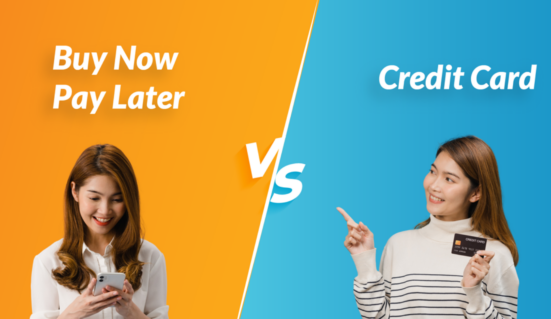Buy Now Pay Later (BNPL) is currently a universal payment trend. Thanks to BNPL, merchants can sell more while consumers can buy what they want faster and more conveniently. However, we also have credit cards with a long history. Choosing which method to use depends on how flexible you can be with your finance, how you plan to pay off the debts, and how attractive you see the perks and incentives they offer. This article will help you better understand these two payment methods.
9 Aspects that Buy Now Pay Later differentiates from credit card
1. Line of Credit
2. Application Process
3. Availability
4. Physical nature
5. Fees
6. Interest rates
7. Repayment
8. Other offers
9. Consequences
WHAT IS BUY NOW PAY LATER?
Buy Now Pay Later is a type of short-term financing. It allows people to buy and receive goods or services immediately, but they must be paid off within a specified time. The use and payments of Buy Now Pay Later are generally free of interest or charges. However, missed payments can result in penalties and due fees.
Some popular providers of Buy Now Pay Later products are Klarna, Afterpay, Paypal, Affirm, etc.
HOW CREDIT CARD IS DIFFERENT FROM BUY NOW PAY LATER
People can easily get confused by Buy Now Pay Later, as it sounds quite similar to credit cards. In fact, Buy Now Pay Later and credit cards share some characteristics in common. However, there are many important differences that you need to understand to tell them apart.
1. Line of Credit
When you apply for a Credit Card, you will be provided with a line of credit. While some Buy Now Pay Later services also apply lines of credit (like Zip Pay), others evaluate each of your purchases (like Afterpay) and decide whether or not to approve those purchases.
For some consumers, lines of credit limit their spending, which for them is inconvenient. Contrarily, no pre-arranged limit means users can keep on making purchases, don’t have to about their limits, and let their BNPL service providers decide. In typical, the credit limit of a regular Credit Card is higher than that of a BNPL.
2. Application Process
You can create a BNPL account instantly, making it much easier to get started than a credit card. There is also no credit check, no discussion of your debts and assets, no assessment of your income or your ability to repay purchases. While this may appeal to some people—especially those with no income or those with debts to pay—you should seriously consider the liability of taking on additional debt just because no one inspects you and tells you that you shouldn’t.
3. Availability
When applying for a new credit card, you can expect to wait a week or so for the card to arrive. Meanwhile, BNPL grants you a line of credit within just 3 minutes, from which you can buy your goods. However, not all retailers accept BNPL since this service has yet to become mainstream.
4. Physical nature
For a credit card, you need the card to use it and it must be accepted at the point of purchase. Carrying so many cards around can be cumbersome for some people. With Buy Now Pay Later, you can still shop with just a few taps on your phone.
5. Fees
Some providers of credit cards offer them for free to attract customers. This means that they don’t have any direct costs, but many come with fees such as issuance fees and annual fees. These types of fees can be higher when you apply for premium cards.
On the contrary, Buy Now Pay Later has no such fees. Banks that provide Buy Now Pay Later usually do not require users to pay joining charges. However, joining fees can be required by other types of providers or when you are late for payment due.
6. Interest rates
Credit card interests can add up quickly especially when you cannot afford to pay off credit balances month to month (not paying in full). BNPL does not charge this interest rate.
7. Repayment
One of the most appealing aspects of BNPL is that it allows users to divide the cost of their purchases without having to pay any additional interest. This can make it easier to pay off over time transactions that they otherwise may not be able to cover at once. To some extent, many credit card providers have provided the same feature. Many offer up to 55 days of interest-free on purchases.
8. Other Offers
Customers interested in incentives can choose credit cards to enjoy perks such as travel insurance & rewards, airport lounge access, and free flights. Moreover, credit cards can offer a variety of perks when cardholders meet preset criteria.
9. Consequences
What would happen if you cannot pay what you owe? For Buy Now Pay Later, failure to pay the BNPL amount due will typically incur fees and may bar you from further purchases. If you have a habit of missing dues, you may be reported to CIC, which will negatively affect your credit score. With Credit Cards, you may be charged a late fee, plus interest on your balance. Similarly, missed payments on credit cards may be reported to the CIC.
Conclusion
Both Buy Now Pay Later and Credit Cards have their good and bad sides. If you are a responsible spender, you may find an advantage in one of two options. Or really, you can use both to maximize the benefits and get the most out of what each option has to offer. The key to doing that is understanding how they work and how to make them work for you.







